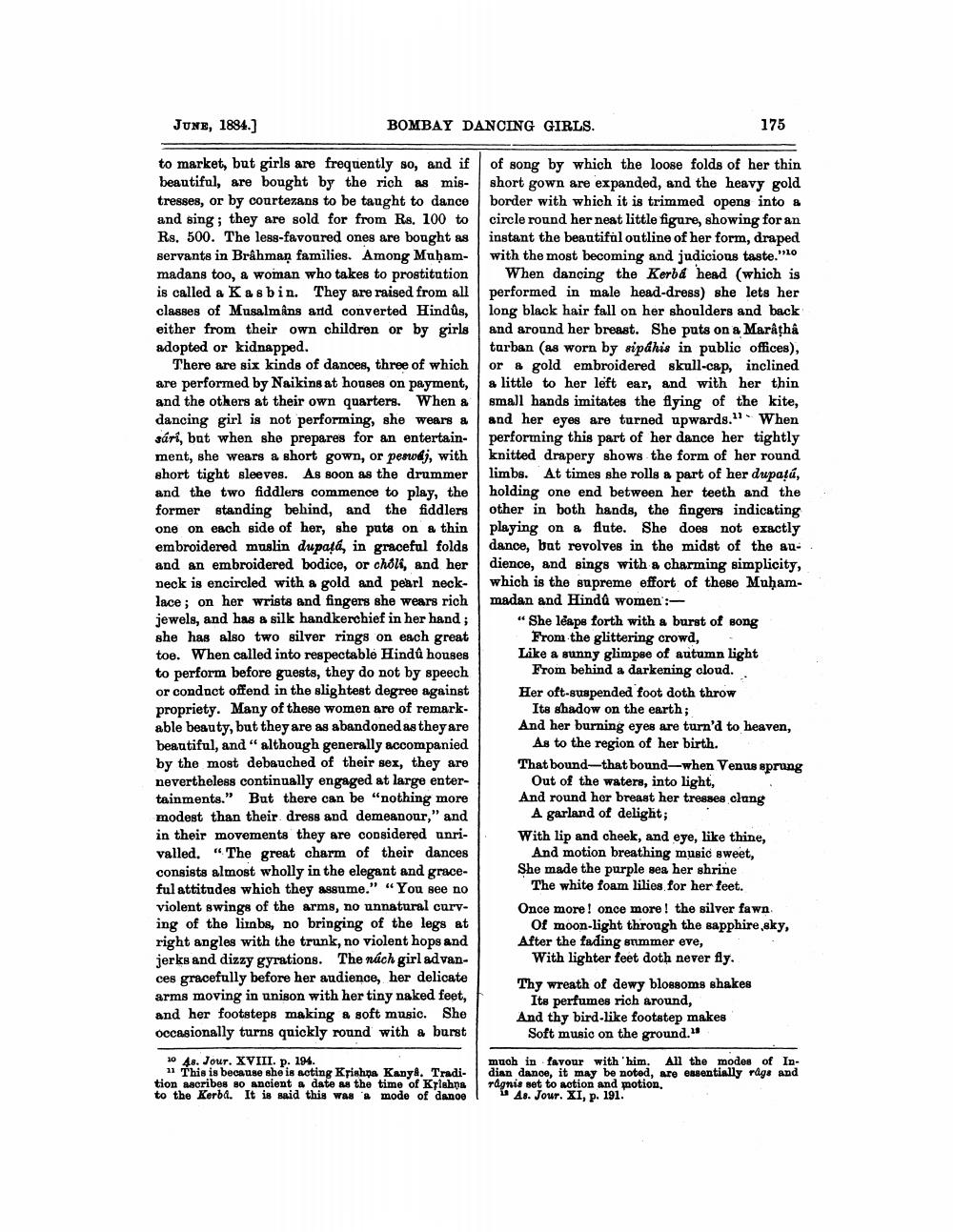________________
JUNE, 1884.)
BOMBAY DANCING GIRLS.
175
to market, but girls are frequently so, and if beautiful, are bought by the rich as mis- tresses, or by courtezans to be taught to dance and sing; they are sold for from Rs. 100 to Rs. 500. The less-favoured ones are bought as servants in Brâhman families. Among Muḥammadans too, a woman who takes to prostitution is called a Kasbin. They are raised from all classes of Musalmans and converted Hindús, either from their own children or by girls adopted or kidnapped.
There are six kinds of dances, three of which are performed by Naikins at houses on payment, and the others at their own quarters. When a dancing girl is not performing, she wears a sári, but when she prepares for an entertain- ment, she wears a short gown, or peswdj, with short tight sleeves. As soon as the drummer and the two fiddlers commence to play, the former standing behind, and the fiddlers one on each side of her, she puts on a thin embroidered muslin dupatá, in graceful folds and an embroidered bodice, or choli, and her neck is encircled with a gold and pearl neck- lace; on her wrists and fingers she wears rich jewels, and has a silk handkerchief in her hand; she has also two silver rings on each great toe. When called into respectable Hindú houses to perform before guests, they do not by speech or conduct offend in the slightest degree against propriety. Many of these women are of remarkable beauty, but they are as abandoned as they are beautiful, and" although generally accompanied by the most debauched of their sex, they are nevertheless continually engaged at large entertainments." But there can be "nothing more modest than their dress and demeanour," and in their movements they are considered unrivalled. “The great charm of their dances consists almost wholly in the elegant and graceful attitudes which they assume." "You see no violent swings of the arms, no unnatural curving of the limbs, no bringing of the legs at right angles with the trunk, no violent hops and jerks and dizzy gyrations. The nách girl advances gracefully before her audience, her delicate arms moving in unison with her tiny naked feet, and her footsteps making a soft music. She occasionally turns quickly round with a burst
40 48. Jour. XVIII. p. 194. 11 This is because she is acting Krishna Kanya. Tradi- tion ascribes 80 ancient a date as the time of Krishna to the Kerba. It is said this was a mode of dance
of song by which the loose folds of her thin short gown are expanded, and the heavy gold border with which it is trimmed opens into a circle round her neat little figure, showing for an instant the beautiful outline of her form, draped with the most becoming and judicious taste."
When dancing the Kerbd head (which is performed in male head-dress) she lets her long black hair fall on her shoulders and back and around her breast. She puts on a Maráthâ turban (as worn by sipahis in public offices), or a gold embroidered skull-cap, inclined a little to her left ear, and with her thin small hands imitates the flying of the kite, and her eyes are turned upwards.". When performing this part of her dance her tightly knitted drapery shows the form of her round limbs. At times she rolls a part of her dupatú, holding one end between her teeth and the other in both hands, the fingers indicating playing on a flute. She does not exactly dance, but revolves in the midst of the audience, and sings with a charming simplicity, which is the supreme effort of these Muhammadan and Hindû women':
She leaps forth with a burst of song
From the glittering crowd, . Like a sunny glimpse of autumn light
From behind a darkening cloud. Her oft-suspended foot doth throw
Its shadow on the earth; And her burning eyes are turn'd to heaven,
As to the region of her birth. That bound that bound-when Venus sprung
Out of the waters, into light, And round her breast her tresses clang
A garland of delight; With lip and cheek, and eye, like thine,
And motion breathing music sweet, She made the purple sea her shrine
The white foam lilies for her feet. Once more! once more! the silver fawn
Of moon-light through the sapphire sky, After the fading stimmer eve,
With lighter feet doth never fly,
Thy wreath of dewy blossoms shakes
Its perfumes rich around, And thy bird-like footstep makes
Soft music on the ground.
much in favour with him. All the modes of Indian dance, it may be noted, are essentially rågs and Tågnis set to action and potion.
"As. Jour. XI, p. 191.




